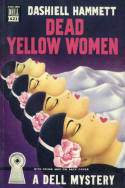 |
Dell |
|
Click the group of books beginning with number:
Later Dell Books
|
Some of the most collectible of all paperbacks, the Dell Mapbacks were primarily mysteries with a few token westerns and romances thrown in for good measure. Dell used a great deal of original art to grace their back covers, the most famous of which included the "Scene of the Crime" maps featured on most of the first 600 books. I've included original back-cover art whenever I could. Dell obviously used a different glue than most paperback houses (at least for the first decade or so). And that, combined with a fabric binding for their pulp pages, has had some interesting aging effects. The books are generally more pliable than most other paperbacks. Cocked (or “tilted”) spines are more prevalent in Dells. High moisture can have a warping effect on some books, especially those issued without laminate, or whose laminate has been removed. This makes Dells more difficult to scan, especially the back covers, since the books tend to tilt or warp toward the front. Usually, no printing information is listed in Dell books except for the original copyright date. Often, later printings simply took another edition number, and all cover art, front and back, remained the same. (Where different cover art DOES appear on different edition numbers for the same title, I’ve listed them in my "Artistic Interpretations” section.) Dell 233, for example (The Upstart), was reprinted with the same cover art as Dell 341 and then again as Dell 1341. This adding of the one thousand digit was common in Dell reprints. This meant that later, as Dell broke through the 1,000 edition level, they had to shift exclusively to other labels, such as Dell First Edition and the Dell lettered-series books. The Dell 10˘ editions constituted a failed experiment in 1951. Each of the 36 books in this label was 64 pages in length and comprised a complete novelette. D-Series books were Dell's 35˘ offerings and the "F" series were "fifty-cent" books. In the "First Edition" series, "A" books sold for a quarter, "B" for 35˘, and "C" for 50˘. The Special Series section (at the bottom) will include a wide range of books. There were four "No-Number" books. Two were printed in 1947 (the cartoon character books). The two digest-sized "Told in Pictures" books (which are exceedingly rare) were printed in 1950 (for more information, click HERE.) This also includes Dell Grove, Dell Yearling, and the Dell Purse Books from the 70's. Also, there are a few dell digest-sized magazines with their characteristic square colophon. Dell Candlelight and Dell Candlelight Regency books sported not only a number indicating their place in that series, but a regular Dell number, as well. After much speculation, I've decided to leave them in their place in the overall numbering sequence. (Many thanks to Ken Johnson and Kathy Godfrey for helping me sort that out.)
The Great Dell Book-Numbering Mystery The numbers on Dell books were pretty straightforward for the first two or three decades. The numbers were in printing sequence (with the exception of a few reprints that added a "one thousand" digit, as mentioned above). But then, after the "lettered series," they switched to a "four digit" series ... and entered into a system that is unique in the literary world. I'm being too kind ... it was absolutely bizarre! Dell set aside "blocks" of 4-digit numbers, and then assigned a designation based on the first letter of the title. And so, for example, book numbers starting with "00" have a title that begins with the letter "A," but they are not necessarily in alphabetical order beyond that. Starting with "04," the titles begin with the letter "B;" and those starting with "10," begin with "C." Sort of. You will notice in the "transition areas," there is some flopping back and forth (between "C" and "D," for instance, around the "1600" mark). With the book numbers between 2200 and 2800, the titles begin with both "E" and "F" indiscriminately. And on it goes. And so, a book with a number in the "9000" range (that has a title beginning with the letter "W") might have been printed significantly before a book with a number in the "1200's" (that has a title beginning with the letter "C"). If you note books within certain series, such as the Dell Candlelight series, their "series numbers" will be completely out of sequence. The sequence WAS in printing order for the series (for example, Candlelight #219 followed Candlelight #218), but NOTHING is in printing order within the 4-digit numbers. They are only listed according to the first letters of their titles. (Many thanks to Vintage Paperback expert Lynn Munroe for attempting to explain this to me.)
Dell was updated in April, 2022
|